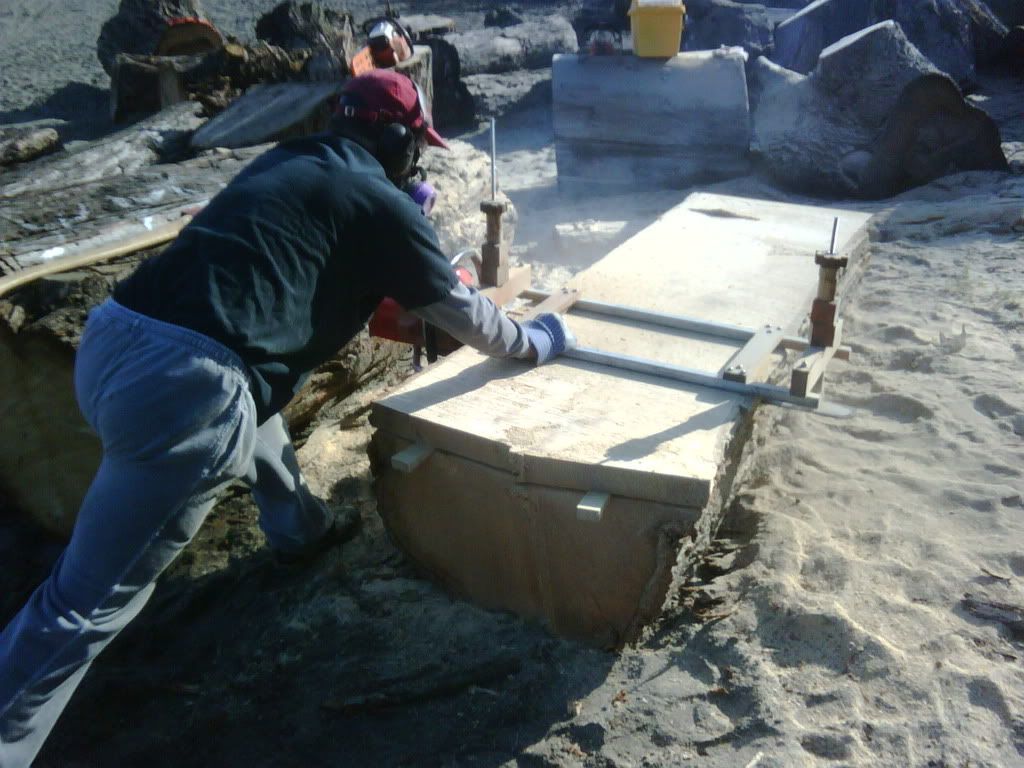Though a few folks here have had a few breaks, so I'm not sure if it's more of an hours issue or a maintenance issue that accounts for the difference.
I Agree. If milling chains are likely to break, the tough conditions encountered during the milling of Aussie timber are probably a good place to see what happens.
Anyway, have a look at this break discussed in grimy detail on an Aussie Milling Forum.
This guy was continually breaking his newish chain, on a new sprocket.
A) Newish chain
B) New sprocket
C) But just take a look at his bar?
My explanation was for this break was;
1) New chain placed on an undressed bar.
2) The chain is not in full contact with the bar so chain is riding or slipping on and off those little lips on the bar rails (See Picture B above).
3) The lips are not dead square notches but slightly wedge shaped like in this picture.
This also explains the groove along the bottom edge of the cutter and the mangled backs of the drive links (see picture A).
4) constant pressure on the chain pushes the chain down into the wedge jamming the chain down into the bar, loading up the rivets and stretching the chain. If it doesn't jam, the undressed bar can tilt the cutter over getting it to take too wide a side bite - chain could load up and break here.
5) The effect of the chain stretch is shown up by the mangled areas between the sprocket slots (see red outlined areas in Picture B) and teh corresponding mashed backs of the drive links
6) Eventually stretch is so great it allows a drive links to jump a drive sprocket slot which tears the drive link away from the cutter.
I think if you have the nose guard on the mill and clutch cover on the saw in place, it would be pretty tricky for you to get whipped by a broken chain.
Yep - agree.
If it breaks on the nose end, there's no way it's going to be able to whip you since it'll just jam against the uncut wood ahead of the bar. And if it breaks at the saw end, there should be plenty of structure in the way to prevent any sort of major incident. I've never felt the need to wear chaps etc. while milling, but obviously good gloves and face (at least eye) protection are a must just in case.
The most likely place for the chain to break when milling is the same as a CS in regular use, either on the sprocket or somewhere between the sprocket and the cutters in contact with the wood. If the chain breaks somewhere in the cut, the "whip around" can only be as long as the distance between the sprocket and the log. But if the operator stands facing the top of the CS, the operator has the entire saw between them and the chain. This is also a good reason to push and not pull a mill. A chain catcher is also not necessary on conventional mill because the bar clamp will act as an chain catcher. Also the inboard verticals will act as a chain catcher to some extent.
The risk of an operator being hit by a chain breaking on the back of the bar while standing in the regular milling position is very very low because the sprocket is pushing the chain away from the operator. It usually just ends up just folding itself up inside the kerf.
Even though the risk is very low I still wear chaps while milling. It's mainly a habit from regular saw use - every time I use a saw I put my chaps on, that way I don't forget in between slabs or logs when I go to use a CS in a regular way.
Recently I did a sort of a basic risk assessment for milling and I will post that in the milling sticky.











